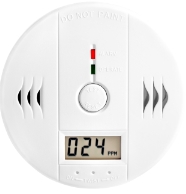KFR and Utilities Kingston shine a spotlight on Carbon Monoxide Awareness Week, Nov. 1- 7

Beat the Silent Killer: Prevent CO in Your Home
It’s Carbon Monoxide Awareness Week in Ontario (Nov. 1-7), and Kingston Fire & Rescue (KFR) and Utilities Kingston are teaming together to remind residents to prevent carbon monoxide (CO) at home by having all fuel-burning appliances inspected annually.
“In Ontario, more than 65 per cent of injuries and deaths from CO occur in the home,” says KFR Fire Chief Shawn Armstrong.
“While natural gas is a safe and reliable fuel, we want to make sure everyone is safe from CO. Have a TSSA registered heating contractor perform yearly maintenance of your gas-fired equipment and venting system to ensure efficient, safe operation,” says Jim Keech, President and CEO of Utilities Kingston.
Residents can visit COSafety.ca to find a registered contractor.
KFR is also reminding all residents to install CO alarms in their home if they have a fuel-burning appliance, a fireplace or an attached garage. Fuel-burning appliances can include furnaces, hot water heaters, gas or wood fireplaces, portable fuel-burning heaters and generators, barbeques, stoves and vehicles.
“You must have a working CO alarm adjacent to each sleeping area of the home if your home has a fuel-burning appliance, a fireplace or an attached garage,” says Armstrong. “For added protection, install a carbon monoxide alarm on every storey of the home according to manufacturer’s instructions.”
If you live in a condo or apartment building with a service room, CO alarms must be installed in the service room and adjacent to each sleeping area of all homes above, below and beside the service room. In condo or apartment buildings that have a garage, CO alarms must be installed adjacent to each sleeping area of all homes above, below and beside the garage.
“We hope all residents will take this opportunity to ensure their homes are protected,” say Armstrong.
What is CO?
- CO is known as the silent killer because it is an invisible, tasteless and odourless gas that can be deadly.
- CO is produced when fuels such as propane, gasoline, natural gas, heating oil or wood do not burn completely in fuel-burning appliances and devices such as furnaces, gas or wood fireplaces, hot water heaters, stoves, barbeques, portable fuel-burning heaters and generators and vehicles.
Prevent CO in your home
- Ensure fuel-burning appliances, chimneys and vents are cleaned and inspected annually. Visit COSafety.ca to find a registered contractor near you.
- Check that all outside appliance vents clear and free from blockages.
- Gas and charcoal barbeques should only be used outside, away from all doors, windows, vents, and other building openings. Never use barbeques inside garages, even if the garage doors are open.
- Portable fuel-burning generators should only be used outdoors in well-ventilated areas away from windows, doors, vents and other building openings.
- Ensure all portable fuel-burning heaters are vented properly, according to manufacturer’s instructions.
- Never use the stove or oven to heat your home.
- Open the flu before using a fireplace, for adequate ventilation.
- Never run a vehicle or other fueled engine or motor inside a garage, even if the garage doors are open. Always remove a vehicle from the garage immediately after starting it.
Know the symptoms of CO
- Exposure to CO can cause flu-like symptoms such as headaches, nausea, dizziness, as well as confusion, drowsiness, loss of consciousness and death.
- If your CO alarm sounds, and you or other occupants suffer from symptoms of CO poisoning, get everyone out of the home immediately. Then call 9-1-1 or your local emergency services number from outside the building.
- If your CO alarm sounds, and no one is suffering from symptoms of CO poisoning, check to see if the battery needs replacing, or the alarm has reached its "end-of-life" before calling 9-1-1.
Know the sound of your CO alarm
- Your CO alarm sounds different than your smoke alarm. Test both alarms monthly and make sure everyone in your home knows the difference between the two alarm sounds.
- Don’t be confused by the sound of your CO alarm’s low-battery warning. Follow your CO alarm manufacturer’s instructions so you know the difference between the low-battery warning, the “end-of-life” warning, and the alarm alerting you to the presence of CO in your home.
For more CO safety tips, visit the Office of the Fire Marshal and Emergency Management’s website and COsafety.ca.